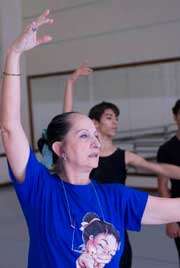The National School of Ballet trains dancers with very high technical and artistic level and a particular way of dancing that distinguishes them in any part of the world.
Many will ask themselves: where lies the secret of a style that has earned fame and respect worldwide? The director of the institution, professor Ramona de Saá Bello, main authoress of the creation and national introduction of the Cuban ballet teaching method, reveals the mystery that has become a myth when she states: “Among the peculiarities of the Cuban teaching methodology of ballet is the incorporation in the study plans of the creation and teaching of a movement in preparation of the following, and the way in which the learning phases, stages and music are added with the purpose of preparing the student for the execution of each movement with its own characteristics”.
“We are also distinguished by the repetition within the variations and the work with the balance, which we start teaching from the first years of the elementary level – all mechanisms that are very well grounded in the study plans”.
Under the direction of Fernando Alonso, a legend of Cuban dance, Ramona founded the School of Ballet of the National School of Art, where the new promotions of Cuban dancers were to be trained.
She is one of the dancers who founded the Cuban National Ballet, and also National Prize of Dance 2006, promoter and creator of the career of Dancing Art at the University of the Arts (ISA).
The outstanding professor also mentions as another peculiarity of the School the fact that the men never train together with the women. “They are separated since they are small, when they start the basic level. That is why the women’s dance is so feminine, and the dancers like me who are trained with that characteristic have this beautiful seal, regardless of the style and role we play, while the men have their manly attitude, their way of moving, the gestures toward the girls and the elegance that identify them as Cuban dancers”.
About the contributions of the School to the development of ballet in the country she pointed out: “They are many, because the first graduation of dancers was in 1967 and the majority of them joined the Cuban National Ballet. Then, in 1978 an entire generation went to strengthen the ranks of the Ballet of Camagüey; then the ballet of Santiago de Cuba was founded and a small project arose in the province of Holguín. We have very good dancers, with brilliant training, with great rigor, throughout the world, emerged from our School”.
“The School forms comprehensive dancers. The study plan comprises folklore, character and historical dances and repertoire, among other subjects. We are a source for the National Ballet in the first place; we also contribute specialists to the Ballet of Camagüey and Pro Danza, which are classic ballet companies, as well as to other dance companies in the Island and abroad, but also to the Cuban Radio and Television Institute and night centers. When the students graduate they are apt to work in any national or international company”, added Ramona, who was a pupil of prima ballerina assoluta Alicia Alonso and is currently a member of the Expert Committee of the World Prize to the Dance sponsored by the Principality of Monaco.
The also honorable Doctor in Art pointed out the importance of training a public that enjoys and understands this art. “A perfect source for this purpose is the elementary level of ballet that is taught in the schools as well as the vocational workshops conducted twice a week with pupils from all municipalities of Havana”.
Since 2000, the venue of the National School of Ballet is a beautiful mansion built in 1904, located in the centric Paseo del Prado of Havana. Among the most outstanding characteristics of the four-story building are the luxury marble staircase and marble floors, the numerous windows and the polychrome nature and harmony between the roundness of the columns and the varied outer and inner decorations, with ceilings embellished with varied elements. The carpentry maintains its style and the floors conserve their original Carrara marble slabs.










